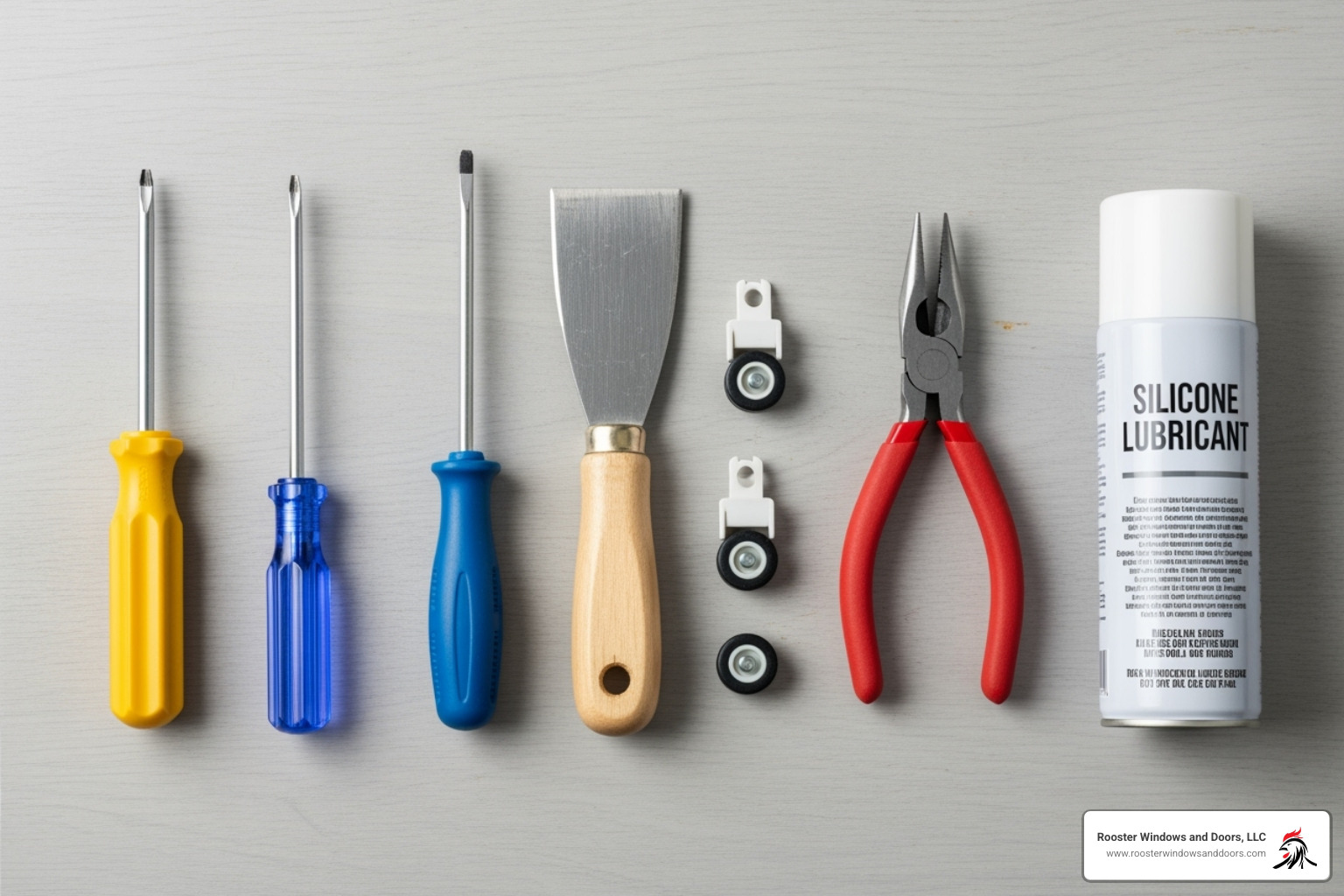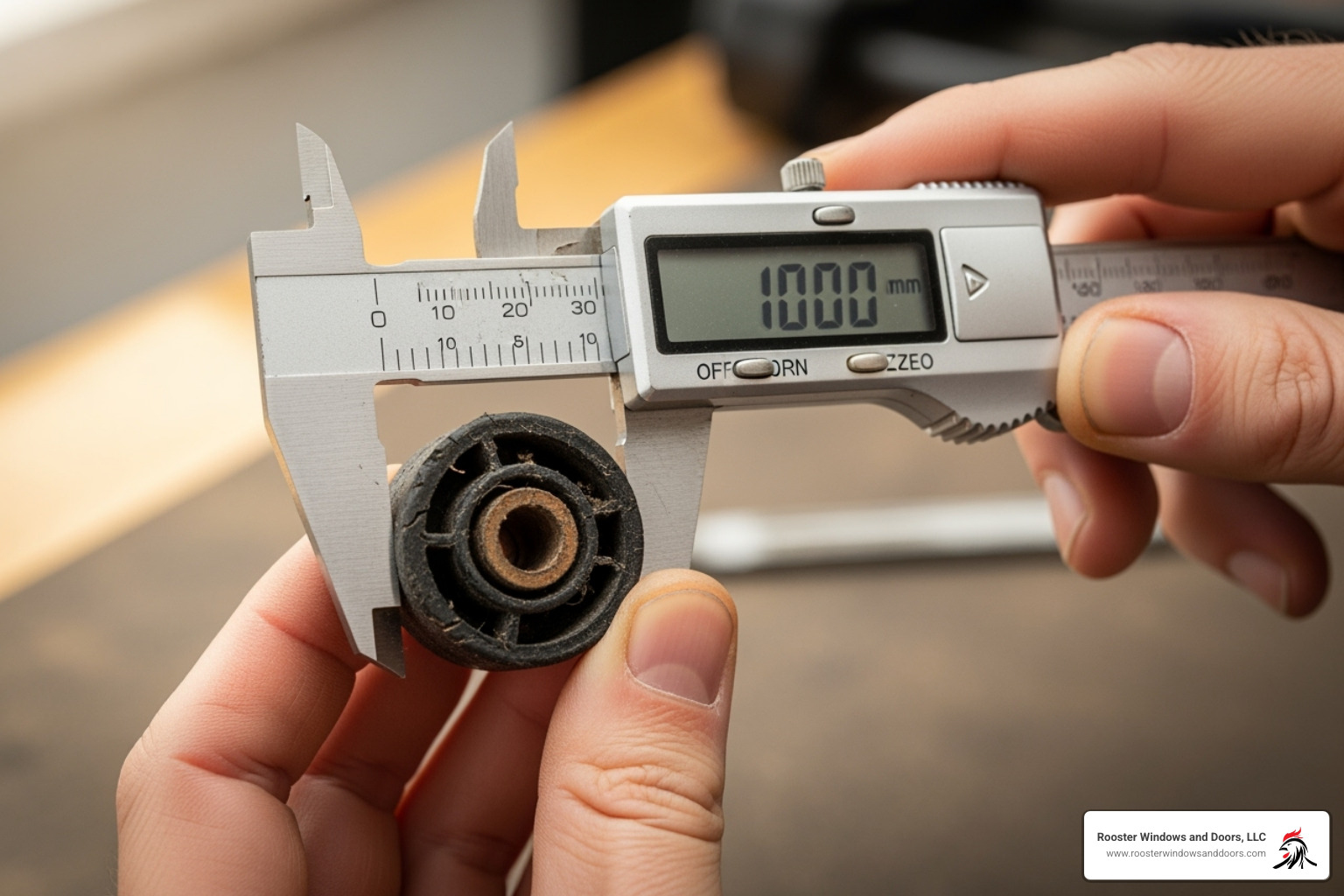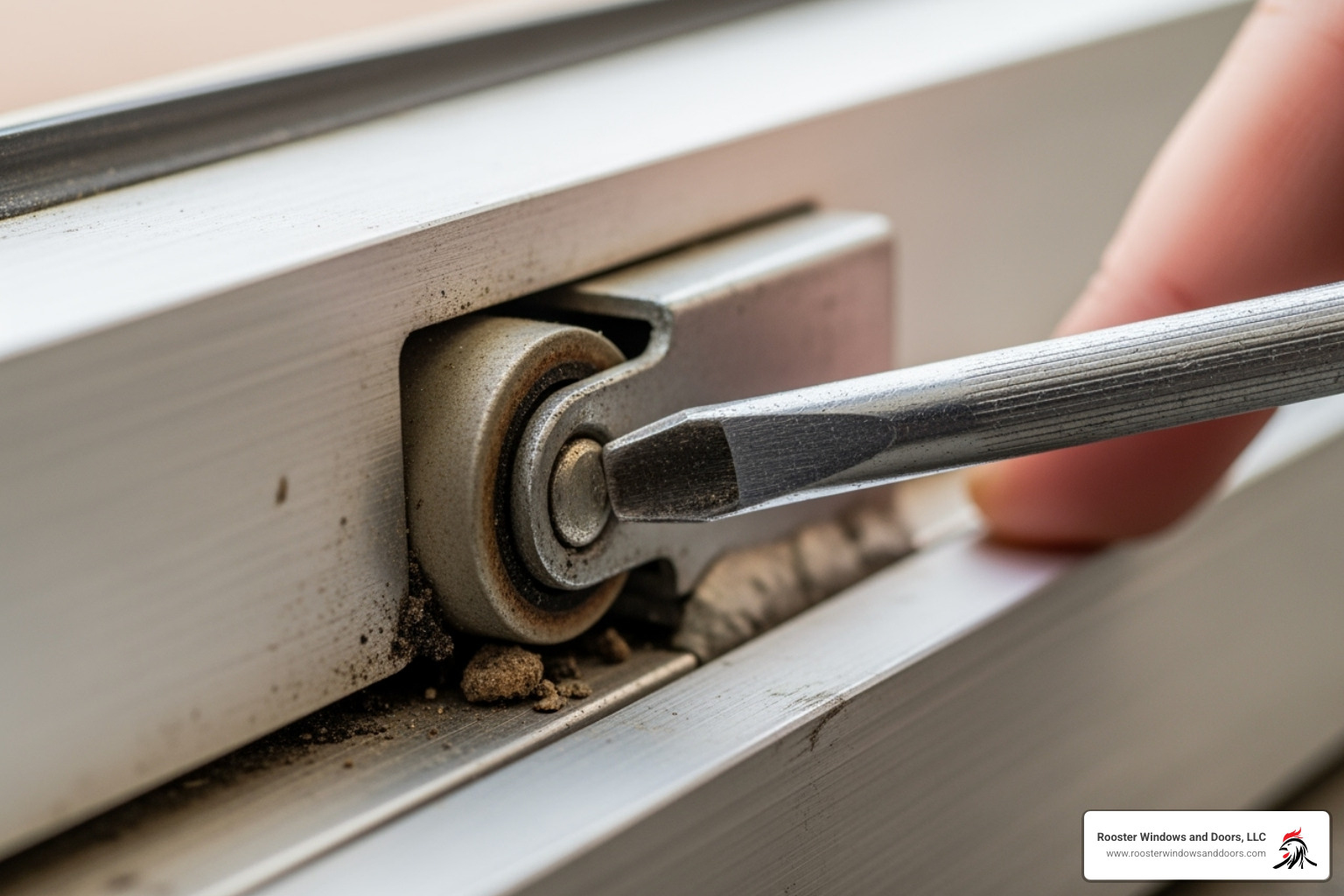Why Replacing Patio Screen Door Rollers is Essential for Smooth Operation
Replacing patio screen door rollers is a common DIY repair for screen doors that stick, make grinding noises, or jump off the track. Instead of struggling with a door that won’t slide, this simple repair can restore its functionality in a few hours.
Quick Answer: Replacing Patio Screen Door Rollers
- Remove the door – Loosen adjustment screws and lift the door from the track.
- Take out old rollers – Remove retaining screws and pry out worn roller assemblies.
- Install new rollers – Insert replacement rollers and secure with screws.
- Reinstall and adjust – Place door back on track and fine-tune roller height.
- Cost: DIY parts cost around $15 vs. a $150 professional minimum charge.
Patio door rollers typically last 10-15 years, but when they fail, the symptoms are unmistakable. Your once-smooth sliding door becomes difficult to open, makes squeaking or grinding sounds, or even falls off its track entirely.
What many homeowners don’t realize is how affordable this fix can be. While a professional service call starts at $150, the parts for a DIY roller replacement cost just $15, making this one of the best value home repairs you can tackle yourself.
I’m Piotr Wilk from Rooster Windows and Doors, LLC. With over two decades of experience in the Chicagoland area, I’ve seen how this simple repair can save homeowners from costly full door replacements. This guide will walk you through the process step by step.

Easy replacing patio screen door rollers glossary:
- Patio door replacement options
- how to install a replacement patio door
- installing vinyl sliding glass door
Before You Begin: Tools, Parts, and Preparation
Proper preparation is what separates a frustrating afternoon from a satisfying DIY victory. Before you begin replacing patio screen door rollers, gather your tools and parts to make the process smoother.
Signs Your Rollers Need Replacing
Your patio screen door should glide effortlessly. When it doesn’t, the rollers are usually the culprit. Here’s how to tell if it’s time for a replacement.
- Grinding or squeaking noises are the most obvious red flags. This usually means debris is in the mechanism or the rollers are wearing down.
- A door that’s difficult to slide open requires more force than it should. This indicates the rollers have stopped rolling and started dragging.
- Doors that jump off the track or feel bouncy have severely compromised rollers. This is an annoyance and a safety concern.
- Visible damage to the roller wheels at the bottom of your door is a clear sign. If they are flat, cracked, or missing chunks, they need to be replaced.
- Uneven gaps around your door frame often mean one or more rollers have collapsed, causing the door to sag. This creates drafts and makes the door look crooked.
Catching these problems early prevents damage to your door frame and track, which can turn a simple roller replacement into a much bigger headache.
Gathering Your Tools and Materials
Having everything ready before you start makes this job much easier.

- Screwdrivers (Phillips and flat-head) are essential for adjustment screws and prying tasks.
- Pliers are handy for gripping small parts or stubborn pins.
- A putty knife or flat pry bar helps lift the door out of its track without scratching the frame.
- Replacement rollers are the key component.
- Silicone-based lubricant ensures smooth operation after installation. Avoid oil-based lubricants, which attract dirt.
- Cleaning supplies like brushes and rags are important for cleaning gunk from the tracks.
- A helper is highly recommended. Patio doors are heavier and more awkward than they look, and an extra pair of hands makes the job safer.
Measuring and Selecting the Correct Replacement Rollers
Using the wrong rollers will prevent your door from sliding properly. The best approach is to remove one old roller and take it to your local hardware store for an exact match.

- Measure the diameter: Common sizes include 1-inch, 1-1/4 inch, and 1-1/2 inch.
- Check the edge profile: Flat-edge rollers are for flat tracks, while concave or convex rollers are for rounded tracks. Most sliding patio doors use a rounded track system for better stability.
- Choose the right material: Nylon rollers are quieter and less expensive, ideal for lighter doors. Steel ball bearing rollers cost more but handle heavier doors and frequent use much better, providing consistent performance for years. For most standard patio screen doors, steel rollers are worth the investment.
When you remove your old roller, look for any brand markings or model numbers to help find the perfect replacement. Adjustable rollers, which allow you to change the height with a screw, will make installation much easier.
A Step-by-Step Guide to Replacing Patio Screen Door Rollers
Replacing patio screen door rollers is a manageable project that will save you money and restore your door’s smooth operation. The process breaks down into four straightforward steps. Take your time with each one to ensure a lasting repair.
Step 1: Removing the Screen Door from the Track
Screen doors can be heavy and awkward, so having a helper for this step is highly recommended.
First, slide the screen door completely open to access the adjustment screws at the bottom corners of the door frame. These screws control the roller height.
Turn the adjustment screws counter-clockwise to retract the rollers as far as possible. This lowers the door, creating the clearance needed for removal. You may need to lift the door slightly with a pry bar to take pressure off the screws as you turn them.
With a helper, lift the entire door up into the top track of the frame until the bottom edge clears the bottom track. Then, swing the bottom of the door outward away from the house and carefully guide it down and out of the top track.
I can’t stress this enough: ask someone to help you with this step. Wrestling these doors alone can lead to damaged frames or personal injury. Once the door is free, lay it horizontally on a stable, flat surface like a pair of sawhorses or a clean tarp.
Step 2: Removing the Old, Worn-Out Rollers
With the door safely positioned, you can access the old rollers.

The rollers are located in small assemblies in the bottom corners of the door frame. Examine how they are held in place. Most are secured with small screws, but some use metal clips, pins, or a snap-in design.
Remove the screws or carefully extract any clips or pins with pliers. Then, use a flat-head screwdriver or putty knife to gently pry out the old roller assembly. Be careful not to damage the door frame.
As you remove each roller, clean out any accumulated dirt, pet hair, and debris from the housings before moving on.
Step 3: Installing the New Rollers and Cleaning the Track
Before installing the new parts, ensure everything is clean. Use a small brush to clean the roller housings in the door frame.
A crucial step many DIYers skip is cleaning the door track thoroughly. The bottom track collects dirt, leaves, and debris that cause rollers to wear out faster. Use a stiff brush and a vacuum with a hose attachment to clean the entire length of the track. For stubborn grime, use a damp cloth with a mild cleaner.
Once clean, apply a silicone-based lubricant to the track to prevent future sticking and squeaking. Some people also rub paraffin wax along the track as an extra measure.
Now, install the new rollers. If they are adjustable, set them to their lowest position to make reinstallation easier. Slide each new roller assembly into its housing, ensure it is seated correctly, and secure it with the original screws or clips. Do not overtighten.
For more information about maintaining your door system properly, you can learn more about our comprehensive door services.
Step 4: Reinstalling and Adjusting the Door for a Perfect Glide
This final step requires patience and fine-tuning.

Reinstalling the door is the reverse of removal. With your helper, lift the screen door and angle the top edge into the upper track. Once the top is secure, lift slightly and guide the bottom rollers onto the bottom track.
Now, fine-tune the door’s glide. Use the adjustment screws, turning them clockwise to raise the rollers. The goal is to lift the door just enough so it glides freely without dragging on the bottom track.
Test the door’s movement after each small adjustment. Slide it back and forth, listening for any grinding and feeling for resistance. Make small, incremental changes until you achieve smooth, quiet operation.
Finally, check your lock alignment. If the door height has changed, the latch may not line up with the strike plate. Adjust it as needed to ensure the door locks securely.
Congratulations! You’ve just completed a replacing patio screen door rollers project that will provide years of smooth, quiet operation.
When to Repair vs. When to Replace the Whole Door
Sometimes, roller issues are a sign of a bigger problem. While replacing patio screen door rollers can fix a sticky door, there are times when a more comprehensive solution is needed. After two decades in the door business in Chicagoland, I’ve seen many cases where roller replacement wasn’t enough. A door’s condition affects not just its operation but also your home’s energy efficiency and comfort.
The Impact on Energy Efficiency and Door Integrity
When rollers fail and doors start dragging, the problems can cascade into larger issues.
- Worn rollers can damage the door frame through constant grinding and stress on aluminum or vinyl frames, eventually leading to warping or cracking.
- Damaged frames lead to poor seals around your door. When a frame warps, it can no longer maintain a tight seal, creating gaps and drafts.
- Poor seals cause energy loss, forcing your heating and cooling system to work overtime. Learn how insulation impacts your energy bills to understand how much these small gaps can cost you.
If you notice condensation between the glass panes, the insulated glass unit has failed, and its thermal performance is compromised. When the door frame is warped, the glass is cracked, or the locks are beyond repair, replacing patio screen door rollers is only a temporary fix. In these cases, consider a full Door Replacement. Modern, energy-efficient doors can improve your home’s insulation, reduce energy costs, and increase property value.
Common Problems When Replacing Patio Screen Door Rollers
Even confident DIYers can run into issues. Here are common problems encountered when replacing patio screen door rollers:
- Stripped adjustment screws: Old, corroded screws can strip easily, making them impossible to turn. A screw extractor might work, but a damaged screw housing is a more complex repair.
- Bent or damaged track: New rollers won’t fix a track that is dented, corroded, or warped. Inspect the track closely if the door still doesn’t glide smoothly.
- Incorrect replacement parts: Using rollers with the wrong diameter, edge type, or material will prevent the door from working correctly. Always bring an old roller to the hardware store for an exact match.
- Door still doesn’t slide smoothly: If you’ve done everything right and the door still sticks, it may require several small adjustments to the roller height on both sides to get it level.
When these complications arise, or if the door frame itself needs attention, it may be time to call professionals. For complex issues or a complete upgrade, exploring professional installation options can save time and ensure a flawless result.
Frequently Asked Questions about Replacing Patio Screen Door Rollers
Here are answers to the most common questions homeowners have about replacing patio screen door rollers.
How long do patio screen door rollers typically last?
Patio screen door rollers typically last 10-15 years. However, their actual lifespan depends on several factors:
- Usage: High-traffic doors wear out faster.
- Door Weight: Heavier doors put more stress on rollers.
- Material: Steel ball bearing rollers outlast nylon ones, especially on heavy doors.
- Maintenance: Regular track cleaning and lubrication with a silicone-based product extend roller life.
- Environment: Exposure to salt air, sand, and dirt can accelerate wear.
Can I just lubricate my old rollers instead of replacing them?
Lubrication can be an effective first step. If your door is just starting to stick or squeak, a thorough track cleaning and a quality silicone-based lubricant may solve the problem. It’s a quick, inexpensive fix to try first.
However, lubrication is not a cure-all. If rollers are visibly damaged (cracked, flat, or missing pieces), no amount of lubricant will fix them. Grinding noises that persist after lubrication, a sagging door, or rollers that won’t turn are clear signs that replacement is necessary.
My rule of thumb: try lubrication first, but don’t struggle for months with a door that clearly needs new rollers.
When should I call a professional for help?
While this is a great DIY project, there are times when it’s best to call a professional.
- Call for help if the door frame is bent or the track is severely damaged. These are structural issues that require specialized tools and experience.
- If you’re unsure about any part of the process or encounter unexpected problems like stripped screws, it’s wise to get professional help. The cost of breaking a glass panel (which can be $185 or more) outweighs any DIY savings.
- Some heavy or complex doors are best left to someone with experience.
It also makes sense to call us when you’re considering a complete upgrade. If your door issues are part of a bigger picture—high energy bills, drafts, condensation between glass panes—you may be treating a symptom, not the underlying problem.
At Rooster Windows and Doors, we’ve seen countless situations where a new, energy-efficient door was the smarter long-term investment. For complex issues or a complete upgrade, you can explore professional patio door installation options with our experienced team. We serve homeowners throughout Chicagoland, ensuring your door works perfectly for years to come.
Enjoy Your Smooth-Gliding Screen Door
By replacing your patio screen door rollers, you’ve completed a rewarding DIY project. This small repair makes a remarkable difference: no more grinding, sticking, or struggling to open your door.
For about $15 in parts and a few hours, you’ve accomplished what a professional might charge $150 or more for. You’ve saved money and gained valuable knowledge for future maintenance.
Your newly smooth-gliding screen door improves your entire outdoor living experience. It connects your indoor and outdoor spaces seamlessly, allowing natural light and fresh air to flow freely while keeping pests out. A well-maintained door also contributes to your home’s energy efficiency. When your door operates smoothly and seals properly, it prevents drafts and helps maintain your home’s temperature, which can lead to savings on your energy bills.
Of course, sometimes a roller replacement reveals bigger issues. If you found that your door frame is bent, your track is severely damaged, or you’re simply ready to upgrade to a modern, energy-efficient patio door, that’s where our expertise at Rooster Windows and Doors comes in.
Our team has been serving homeowners throughout the Chicagoland area for over two decades, and we understand how the right door can transform a home’s comfort, security, and value. When you’re ready for that next step—whether it’s addressing complex door issues or considering a complete upgrade—explore our professional Patio Door Installation services. We’re committed to providing high-quality, energy-efficient installations that will improve your home’s beauty and functionality.
For now, take a moment to enjoy your accomplishment. Slide that door back and forth and appreciate how smoothly it moves. You’ve earned it!